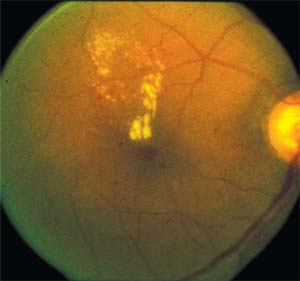A group of researchers from Canada, the United Kingdom and Australia say that a common inflammatory molecule in the eye may be able to tip off physicians about which DME patients will respond best to therapy.
In an article published online in JAMA Ophthalmology, the investigators
 |
set out to discover if levels of inflammatory cytokines in the aqueous had any bearing on DME patients’ response to the anti-vascular endothelial growth factor drug ranibizumab (Lucentis, Genentech).
“Over the years, what we’ve noticed with anti-VEGF injection for DME is that, though anti-VEGF has been a great class of drugs that’s saved a lot of patients’ vision, there’s a subset of patients who don’t respond well to anti-VEGF drugs,” says study co-author Rajeev Muni, MD, assistant professor in the Department of Ophthalmology and Vision Sciences at the University of Toronto. The researchers proceeded to look for biomarkers that might clue them in to the non-responders.
In the prospective multicenter cohort study, 49 patients with diabetes mellitus complicated by center-involving DME received monthly injections of ranibizumab 0.5 mg for three months. They each had a central subfield thickness of 310 µm or greater on spectral-domain optical coherence tomography. At baseline and two months, the researchers obtained aqueous fluid for cytokine analysis. They performed multiplex immunoassays in duplicate for the following:
• VEGF;
• placental growth factor;
• transforming growth factor beta 2;
• intercellular adhesion molecule 1 (ICAM-1);
• interleukin 6 (IL-6), IL-8, IL-10;
• vascular intercellular adhesion mole-cule; and
• monocyte chemoattractant protein 1.
“We demonstrated that there are two cytokines that are particularly important,” Dr. Muni says. “One is VEGF, which makes sense because the drug we use blocks it. However, VEGF was only associated after correcting for certain other variables. The other, more surprising, cytokine that was important was ICAM-1, which was highly associated with patients’ response to treatment. Patients with high levels of ICAM-1 were much more likely to respond to treatment with intravitreal ranibizumab injections, while those with lower levels were less likely to respond to the drug. With VEGF, though, the lower the level, the more likely they were to respond. The higher the level of VEGF, the less likely they were to respond.” Specifically, every additional 100 pg/mL of baseline ICAM-1 was associated with a reduction of 0.0379 mm3 of macular volume after treatment (p=0.01), and every additional 100 pg/mL of baseline VEGF was associated with an increase of 0.0731 mm3. (p=0.02). The latter was also associated with lower odds of that patient being a central subfield thickness responder (odds ratio, 0.868; 95% CI, 0.755-0.998). Dr. Muni says the section of the study discussing the probability of a patient responding to treatment might be particularly interesting to clinicians. “It’s interesting that for every 100-pg/ml increase in ICAM-1, the odds of response increase by 27 percent,” he says. “So, if someone has a 200- or 300-pg/ml level of ICAM-1, the chance of responding rises signficiantly. In the same way, for every 100 pg/ml increase in VEGF, their odds go down by 20 percent. So, this might potentially be powerful in determining who’s going to respond and who isn’t.”
“The main finding of this study is that this kind of represents the beginning of a more personalized approach to measuring a patient’s cytokine levels and using them to help us determine what the best treatment approach would be for that particular patient, or how likely they would be to respond to the drug,” Dr. Muni says. “It could help us guide our treatment for diabetic macular edema in a more targeted, personalized way.”
Restasis Patent Evaluation Proceeds
In late February, a U.S. administrative court ruled that it has the authority to evaluate the validity of Allergan’s Restasis patents despite its transfer to the Saint Regis Mohawk Tribe. The Patent Trial and Appeal Board (overseen by the U.S. patent office) dismissed a request to throw out the litigation of a competing drug company, Mylan NV, challenging Allergan’s handling of its patents on the dry-eye drug Restasis.
In September of 2017, Allergan transferred its patents on Restasis to the New York-based Native American tribe. It was argued that the tribe’s status as a sovereign entity, gave immunity to inter partes reviews of the patents. This had the potential to eliminate the competition that Allergan would normally face from generic companies such as Mylan. The Restasis patents are scheduled to expire in 2024. Until then, unless these patents are invalidated in court, Allergan reserves the sole right to manufacture Restasis. Around the same time as the patent sale to the tribe was occurring, the U.S. District Court for the Eastern District of Texas invalidated four of the six Restasis patents. The judge in that decision also commented on the company’s arrangement with St. Regis Mohawk as the “renting” of tribal sovereignty to serve as a shield from inter partes patent reviews.
However, the Patent Trial and Appeal Board recently denied the Tribe’s motion to dismiss Mylan’s challenge, on multiple grounds. The board ruled that tribal immunity doesn’t apply to patent-review proceedings, dealing a setback to Allergan. In addition, the tribunal ruled that because Allergan had retained ownership interest in the challenged patents, the proceedings could continue without the tribe’s participation or consent, as they had no ownership over them. They also ruled that the tribe failed to establish the doctrine of tribal sovereign immunity. An oral hearing is set for April 3, followed by a written decision that will be due by June 6.
“Mylan has always been vocal in its efforts to challenge and break down barriers to access,” said Mylan’s chief executive officer Heather Bresch in a prepared statement. “We will continue to be steadfast in our efforts on both the legal and regulatory fronts to bring a generic version of Restasis to patients as quickly as possible.”
Allergan declined to comment. REVIEW



